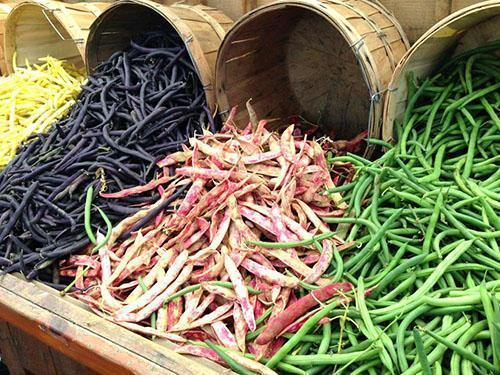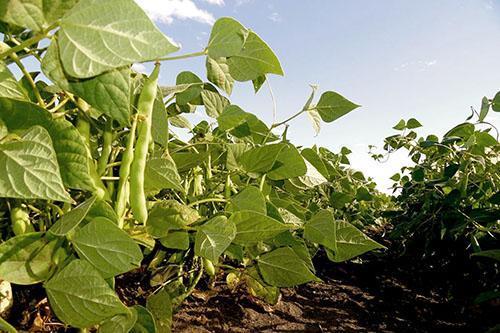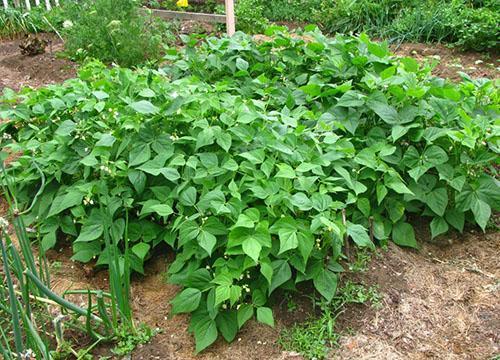We get acquainted with the types and varieties of green beans by photos and descriptions
 All modern species and varieties of green beans are plants belonging to the same legume family, but belonging to different genera: Vigna and Phaseolus. Both varieties have been used by humans for thousands of years, but the growth in consumption of whole pods in the milky-wax stage of ripeness in the world began only a couple of centuries ago.
All modern species and varieties of green beans are plants belonging to the same legume family, but belonging to different genera: Vigna and Phaseolus. Both varieties have been used by humans for thousands of years, but the growth in consumption of whole pods in the milky-wax stage of ripeness in the world began only a couple of centuries ago.
Historians have found the first mention of green beans in Chinese written sources dating back to the 2nd millennium BC. But the oldest material artifacts were found on the other side of the world - in South America. Here bean plants were cultivated by the Inca and Aztec tribes, as evidenced by the fossilized seeds.

The Italians were the first to breed green beans. And then the fashion for dishes from thick juicy shoulder blades moved to France and spread throughout the Old World.
Modern taxonomy of beans varieties
 True, if hearty dishes made from beans were soon considered food for the common people, then pods with thick juicy walls and barely formed seeds turned out to be food for the nobility. The fact is that the blades remained tender for a very short time, and then, with the beginning of the development and maturation of the seeds, the inner surface of the valves was covered with a hard parchment layer. It is not always possible to collect with beds beans of milk ripeness with soft pods.
True, if hearty dishes made from beans were soon considered food for the common people, then pods with thick juicy walls and barely formed seeds turned out to be food for the nobility. The fact is that the blades remained tender for a very short time, and then, with the beginning of the development and maturation of the seeds, the inner surface of the valves was covered with a hard parchment layer. It is not always possible to collect with beds beans of milk ripeness with soft pods.
Over time, as new varieties appeared, a division into:
- sugar or asparagus beans, which lack the fibrous inedible coating of the valves at all, and the seeds are edible, but small;
- semi-sugar or universal varieties, first giving very dense tasty pods, and then forming a good seed yield;
- hulling or grain varieties, the main purpose of growing which is to obtain a bountiful harvest of seeds.
According to the form of plants, when classifying varieties, beans are divided into bush and curly beans.
 Shrub beans, convenient for mechanized and manual harvesting, look like medium-sized erect or somewhat lodging plants with a height of 40 to 60 cm. Such a crop begins to bear fruit earlier, is more cold-resistant and unpretentious.
Shrub beans, convenient for mechanized and manual harvesting, look like medium-sized erect or somewhat lodging plants with a height of 40 to 60 cm. Such a crop begins to bear fruit earlier, is more cold-resistant and unpretentious.
Curly beans, depending on the variety, can form whips up to 5 meters long, therefore, when grown, they require strong supports or trellises. The asparagus bean shown in the photo, the climbing variety is more laborious to maintain and did not ripen as early as the bush variety, but the growing season in this case is longer, as is the number of pods from one plant. In addition, the plants are extremely effective and can be used as decorative beans for landscaping walls buildings, fences and other vertical surfaces.
 In terms of the shape and type of beans, the existing varieties of green beans are also diverse and bear little resemblance to each other.
In terms of the shape and type of beans, the existing varieties of green beans are also diverse and bear little resemblance to each other.
- The length of pods of common green beans, which is more common in European and Russian gardens, reaches only 6–20 cm, and in each of them up to 3 to 8 seeds mature.
- In the pods of the Asiatic cowpea, up to several dozen seeds can be counted, and the shoulder blades grow to a meter length.
The color of green beans, as in the photo, depending on the variety, is white, yellowish, light or bright green, variegated, purple and even almost black. The same variety and color of seeds ripening in pods by autumn.
This classification is true for both the American genus Phaseolus and the Asiatic Vigna, although the pods are strikingly different in appearance.
Description and photos of species and varieties of vigna green beans
 From the point of view of biology, cowpea is a genus consisting of several dozen subspecies of herbaceous plants, which is closely related to the common bean.
From the point of view of biology, cowpea is a genus consisting of several dozen subspecies of herbaceous plants, which is closely related to the common bean.
However, along with the external similarity, there are many differences between the species and varieties of Asian and American green beans. The main thing is:
- the length and structure of the pods, which are noticeably longer and thinner in the cowpea;
- complete absence of a parchment layer on the inner side of the valves;
- fairly small seeds that do not require soaking during cooking.
 In culture, the most common Asian green beans, called cow or snake peas.
In culture, the most common Asian green beans, called cow or snake peas.
Today, there are many varieties of this type of green beans around the world, and the photo shows one of the most beloved in the United States. These are Yardlong beans, which have long become an equivalent substitute for the usual green beans and produce delicious meter-long pods. Such a crop can produce pods not only of traditional green color, but also burgundy or purple. Red cowpea beans are equally popular and interesting to grow.
The genus Vigna includes Asian types of beans - mung bean, urd, adzuki.
 Mung bean or mung bean is one of the oldest domesticated plants from the genus of cowpea. The culture is prized for its small oval-shaped green seeds and is traditional in India, Pakistan and other countries in the region.
Mung bean or mung bean is one of the oldest domesticated plants from the genus of cowpea. The culture is prized for its small oval-shaped green seeds and is traditional in India, Pakistan and other countries in the region.
 Azuki, another species of cowpea, grows in various regions of Southeast Asia, and first entered the culture in the Himalayas. From here beans with red small seeds made their way to China, Korea and Japan.
Azuki, another species of cowpea, grows in various regions of Southeast Asia, and first entered the culture in the Himalayas. From here beans with red small seeds made their way to China, Korea and Japan.
 Today there are varieties of this unusual beans with white, gray, black variegated seeds. And in the Land of the Rising Sun this type of beans is valued almost on a par with soybeans.
Today there are varieties of this unusual beans with white, gray, black variegated seeds. And in the Land of the Rising Sun this type of beans is valued almost on a par with soybeans.
 Urd, also called black mash because of the color of medium-sized seeds, has been known in culture for about 4 thousand years. This type of black bean is widespread in the south and southeast of Asia.
Urd, also called black mash because of the color of medium-sized seeds, has been known in culture for about 4 thousand years. This type of black bean is widespread in the south and southeast of Asia.
 The plant is an annual, herbaceous shrub with a height of 20 to 80 cm. The resulting pods are very small, only 4–7 cm long, covered with hard pile. Both young shoulder blades and mature seeds are eaten.
The plant is an annual, herbaceous shrub with a height of 20 to 80 cm. The resulting pods are very small, only 4–7 cm long, covered with hard pile. Both young shoulder blades and mature seeds are eaten.
 Among the species and varieties of this green beans, as in the photo, plants are extremely spectacular. This is the caracal cowpea, originating from South America and in the European part grown as indoor or garden, ornamental beans.
Among the species and varieties of this green beans, as in the photo, plants are extremely spectacular. This is the caracal cowpea, originating from South America and in the European part grown as indoor or garden, ornamental beans.
At the time of flowering, plants up to 7 meters high are covered with racemose inflorescences of variegated snail-like flowers, which makes this variety of curly beans very attractive for amateur gardening.
If you want to get long cowpea pods on your site that do not have a coarse layer and are eaten without harm even raw, it is not difficult at all. Russian breeders already offer gardeners the first varieties of this type of green beans, which are no different in photo and taste, and even surpass Chinese and Japanese plants in endurance.
Vigna Liana Green Beans
 The curly beans are quite vigorous. Shoots climb to a height of 3 meters, so support is essential for growing. The pods are light green, rough, dense, do not have coarse fibers at the time of milky-wax ripeness. Ripening at the end of the growing season, after 55-60 days, the seeds are round-oval, small, brownish-purple.
The curly beans are quite vigorous. Shoots climb to a height of 3 meters, so support is essential for growing. The pods are light green, rough, dense, do not have coarse fibers at the time of milky-wax ripeness. Ripening at the end of the growing season, after 55-60 days, the seeds are round-oval, small, brownish-purple.
This green bean tastes great both raw and cooked. Young beans can be used to prepare a wide variety of dishes and harvested for future use by freezing and canning.
Photo and description of the variety of green beans Vigna Macaretti
 The length of the pods of this variety of cowpea beans, as in the photo, reaches 30–35 cm. Beans with a slight bend, light green valves and brown seeds, ripening in 60–65 days.
The length of the pods of this variety of cowpea beans, as in the photo, reaches 30–35 cm. Beans with a slight bend, light green valves and brown seeds, ripening in 60–65 days.
This is a variety of curly beans with vigorous growth and excellent taste properties of the shoulder blades, retaining flavor and color even when frozen. Versatility of use, unpretentiousness to growing conditions and decent yield. In addition to varieties with green pods, there are red and purple cope beans, whose shoulder blades are colored in different shades of purple.
Description and photos of species and varieties of common green beans
 For American or common beans, familiar to consumers in Russia and European countries, beans with wider and shorter wings are characteristic. Such pods often have a pointed nose, and they themselves may not be cylindrical, but flattened.
For American or common beans, familiar to consumers in Russia and European countries, beans with wider and shorter wings are characteristic. Such pods often have a pointed nose, and they themselves may not be cylindrical, but flattened.
Among the varieties of green beans, those that form smooth, dense cylindrical pods with thick walls are most appreciated. These are asparagus beans without parchment inclusions inside the shoulder blades and small seed ovaries. In addition to such varieties, gardeners are offered versatile plants, the valves of which coarsen as the nutritious seeds of various colors and shapes mature. Bean pods can be green or white, variegated, yellow or purple. In this case, purple and red beans, during heat treatment, lose their original color and the shoulder blades turn green.
Green beans Crane
 Harvesting bush beans are modest in size. The bush barely reaches 50 cm in height. But at the same time, the plant invariably produces a lot of high-quality gourmet beans, close to a cylindrical shape. The pod length is from 12 to 15 cm, the color of the valves is green. They ripen in 48-50 days from the beginning of the growing season.
Harvesting bush beans are modest in size. The bush barely reaches 50 cm in height. But at the same time, the plant invariably produces a lot of high-quality gourmet beans, close to a cylindrical shape. The pod length is from 12 to 15 cm, the color of the valves is green. They ripen in 48-50 days from the beginning of the growing season.
The seeds of this bean are white, oblong-oval in shape. Beans for universal use, suitable for canning and freezing.
Bluhilda: Vegetable Curly Beans
 An early variety of green beans, purple beans with a high yield and a good taste of bright pods. The multipurpose plant serves as a source of both dietary shoulder blades and mature white beans.
An early variety of green beans, purple beans with a high yield and a good taste of bright pods. The multipurpose plant serves as a source of both dietary shoulder blades and mature white beans.
Purple Queen Beans
A mid-season variety of bush beans with dark, almost black pods, up to 15–17 cm long. The blades are tender, crunchy, without coarse fibers. Bush beans are hardy, tolerate dry periods and temporary cold snaps well.
Flamingo: A variety of green beans with variegated beans
 Hardy bushes of this variety can withstand a load of 50-60 growing beans of an unusual variegated color. The seeds ripening inside the pods are also variegated, of decent quality and nutritional value. Young shoulder blades are tender, full-length and contain a lot of protein and fiber. The multipurpose bush bean variety is unpretentious and has an excellent yield.
Hardy bushes of this variety can withstand a load of 50-60 growing beans of an unusual variegated color. The seeds ripening inside the pods are also variegated, of decent quality and nutritional value. Young shoulder blades are tender, full-length and contain a lot of protein and fiber. The multipurpose bush bean variety is unpretentious and has an excellent yield.
Green Beans Blue Lake
 A very early variety of curly beans with delicate cylindrical pods up to 16 cm long. Inside the beans at the end of the growing season, small white beans ripen, also suitable for food. The plant is tall, demanding on lighting conditions, watering and nutrition. Readily responds to care with a bountiful harvest.
A very early variety of curly beans with delicate cylindrical pods up to 16 cm long. Inside the beans at the end of the growing season, small white beans ripen, also suitable for food. The plant is tall, demanding on lighting conditions, watering and nutrition. Readily responds to care with a bountiful harvest.
Green asparagus beans Laura
 The ripening period of the seeds of this variety is 55–65 days. On the bushes of this variety of green beans, numerous light yellow beans are formed, up to 14 cm long. The pods are cylindrical, with a pointed tip and completely devoid of fibers and parchment inclusions.Plants are bush-shaped, compact, willingly and amicably bearing fruit.
The ripening period of the seeds of this variety is 55–65 days. On the bushes of this variety of green beans, numerous light yellow beans are formed, up to 14 cm long. The pods are cylindrical, with a pointed tip and completely devoid of fibers and parchment inclusions.Plants are bush-shaped, compact, willingly and amicably bearing fruit.
Enchantress - black beans inside white pods
 A characteristic feature of this variety of bush beans is early maturity and black glossy seeds that ripen inside yellow or waxy round beans. The length of the gourmet pods is 14–16 cm. Like the young shoulder blades, black beans are cookable, tasty and contain many valuable nutrients. Plants are resistant to common diseases, hardy and productive.
A characteristic feature of this variety of bush beans is early maturity and black glossy seeds that ripen inside yellow or waxy round beans. The length of the gourmet pods is 14–16 cm. Like the young shoulder blades, black beans are cookable, tasty and contain many valuable nutrients. Plants are resistant to common diseases, hardy and productive.